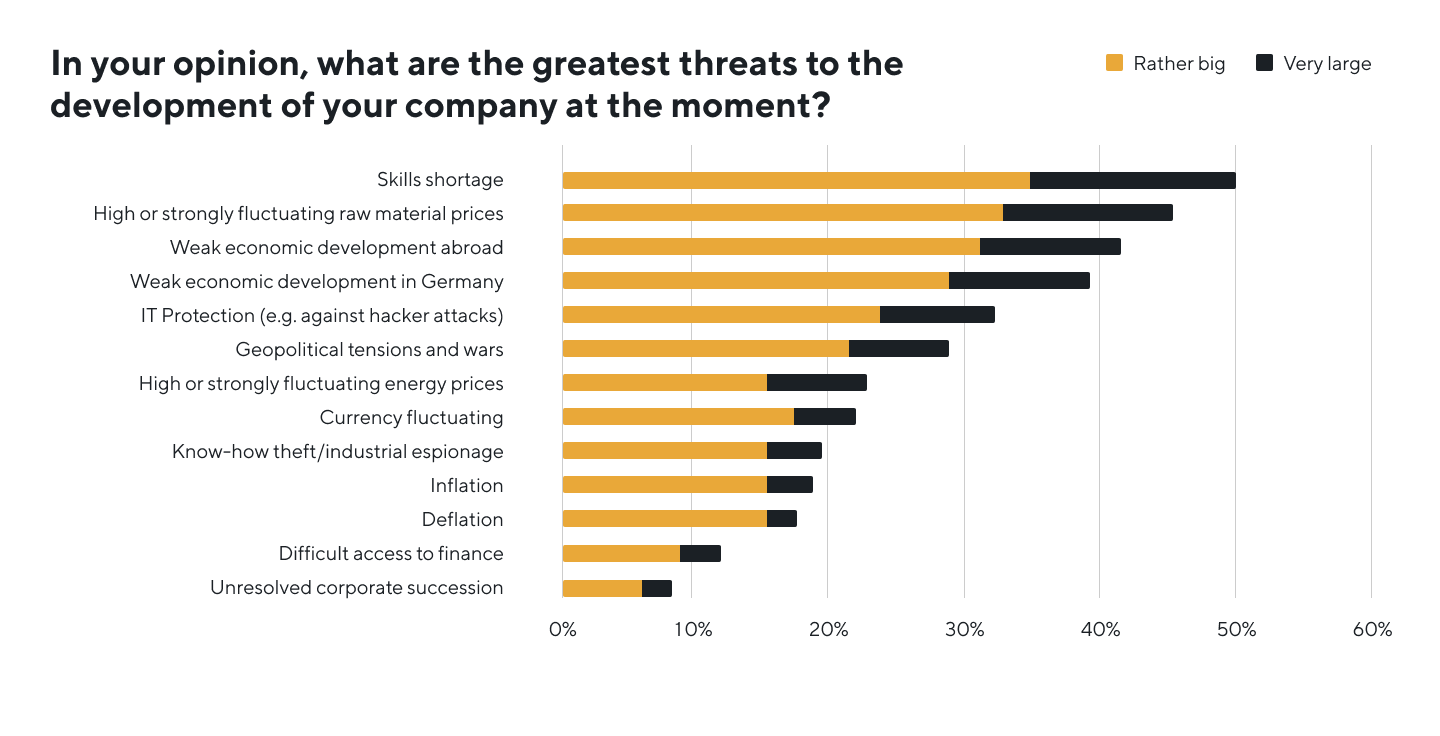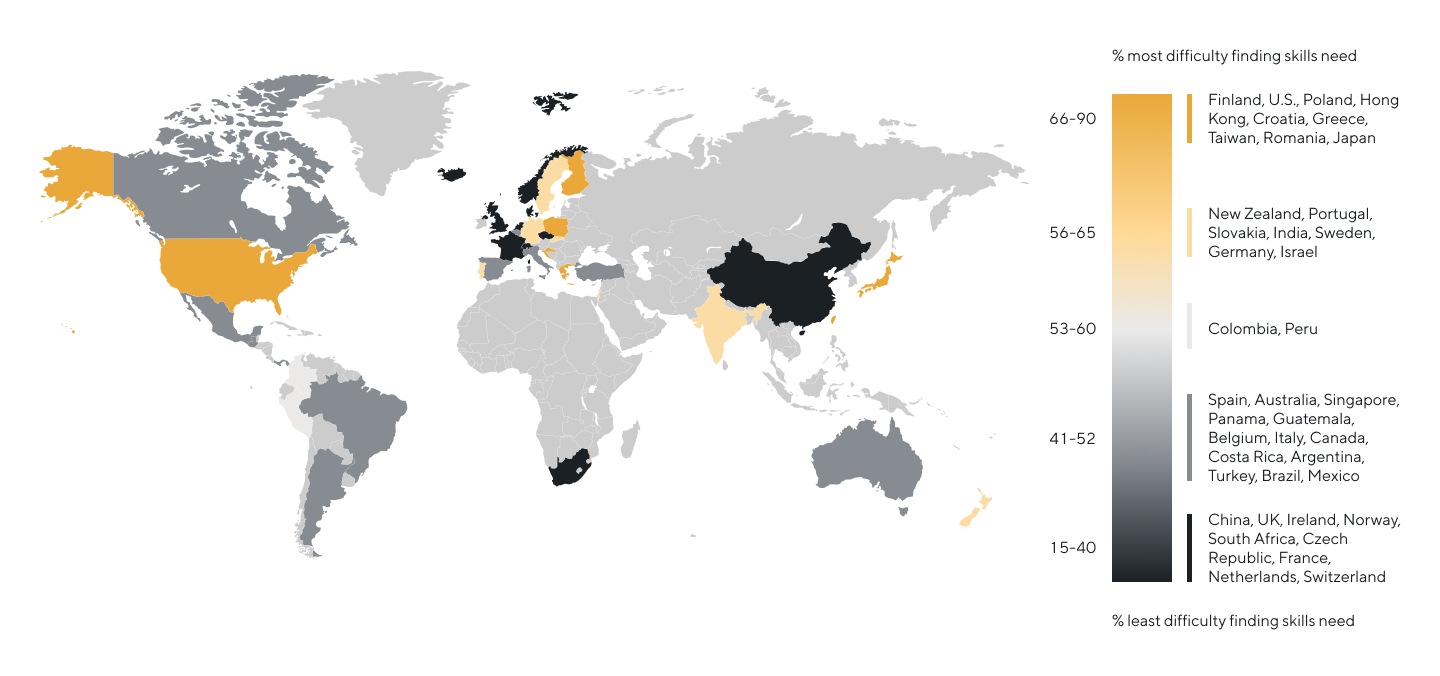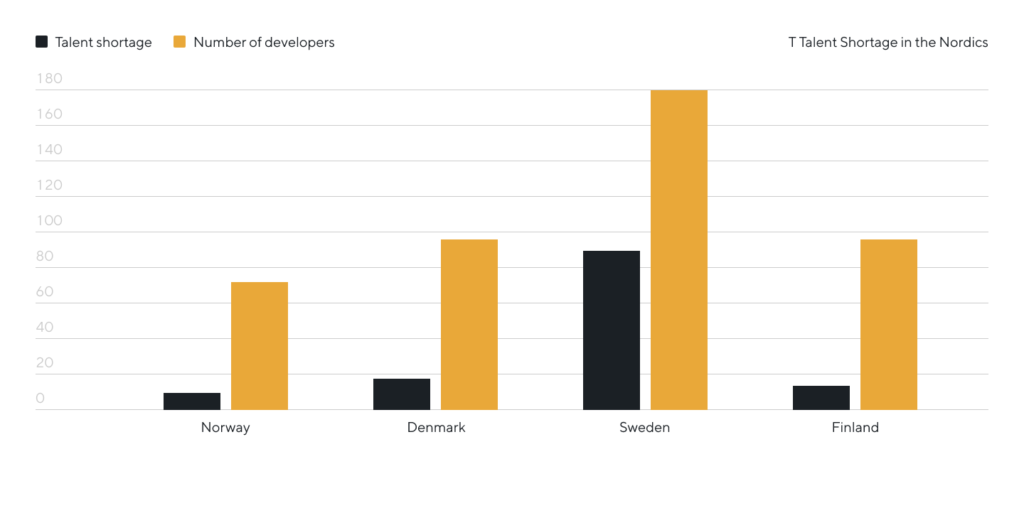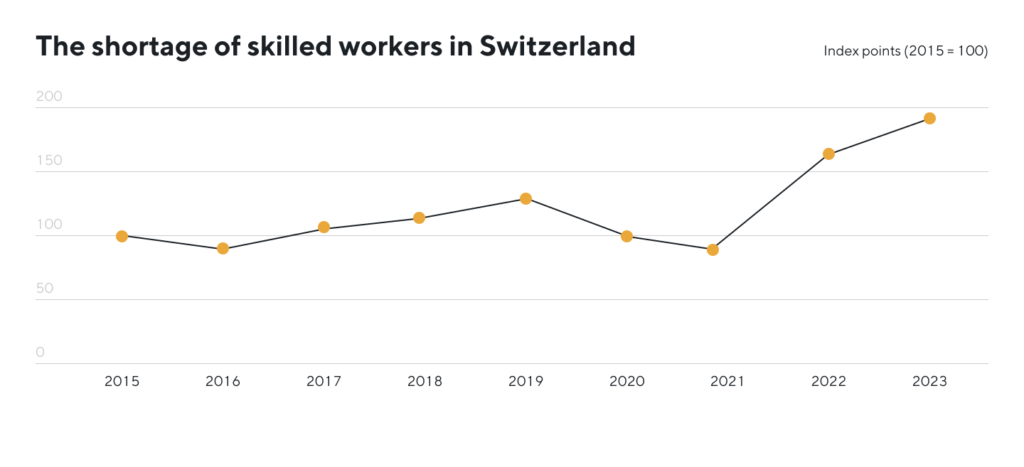In recent years, the software development industry has significantly shifted towards nearshoring. With its attractive business environment, abundant talent pool, and cultural affinity, Eastern Europe and Baltic Countries have emerged as leading destinations for nearshore software development services. Eastern European countries offer numerous benefits to companies seeking to outsource their software development projects, including cost-effectiveness, communication ease, access to skilled talent, time zone proximity, and strict data protection laws. Among the top nearshore outsourcing destinations in Europe, Poland, Ukraine, Romania, Czechia, and Hungary have become key players, offering quality work, competitive pricing, and technical expertise. In this blog, we will explore the reasons behind Europe’s rise as a nearshore software development hub and delve into the unique offerings of these prominent nearshoring destinations. Whether you are considering nearshoring software development services or looking for insights into the nearshoring landscape, this blog will provide you with valuable information to make informed decisions.
Eastern Europe as a Nearshore Outsourcing Software Development Hub
Many European companies seeking nearshoring opportunities have also increased demand for IT professionals. Software engineers, developers, data analysts, designers, and other technical specialists with valuable expertise became highly sought after by local and international companies. Moreover, the European Union’s emphasis on promoting digitalization and technological advancements has further fueled the growth of the IT sector in countries like Poland, Ukraine, Romania, etc. The strict data protection laws enforced within the European Union also reassure companies considering nearshore software development, ensuring the security and confidentiality of their projects. Overall, nearshoring has brought about positive changes in Europe’s IT landscape, boosting economic growth, fostering talent development, and positioning the region as a global leader in software development.
What Impacts Software Skilled Employees Shortage?
When there are more available positions for skilled workers than qualified candidates, it’s referred to as a skills shortage. Those who have completed accredited academic or professional training are considered skilled workers.
The difficulty in locating qualified experts has increased dramatically in recent years. There are several reasons for this:
The labor market is changing, with it, the demand for particular talents. Job types and industries have changed.
Demographic Trends: Aging populations and shifting labor force demographics impact the availability of skilled workers.
Globalization: As companies grow internationally, talent acquisition becomes global, resulting in more intense competition.
Digitalization: Not all workers have adapted to the new skill sets required by the rapid advancement of technology.
Education Policy: How a country prepares its people can narrow or enlarge the skills gap.
War factor. Ukraine and Russia used to be two of the largest global marketplaces for procuring highly qualified IT professionals. Employing Ukrainian and Russian IT specialists helped many American and Western European businesses fill the skills gap in their homelands. However, the Russian software outsourcing business has lost its standing in global IT. It is no longer able to supply engineering expertise abroad due to various sanctions imposed on Russia as a result of its continuous assault on Ukraine.

Source: Tectrain
Information Technology (IT) exemplifies a constantly changing industry. Skilled talents are in high demand due to rapid technological improvements such as cloud computing, data science, machine learning, and artificial intelligence. There is an apparent lack of IT skills since the supply of experts with these cutting-edge talents has yet to keep up.
For example, a severe skill shortage in cybersecurity has grown significantly in importance due to the rise in cyber threats. Comparably, there’s a need for more qualified individuals to fill the increasing demand for specialists in data science and machine learning due to the recent growth of these fields.
The IT industry faces two challenges due to the growing disparity between supply and demand: businesses are finding it difficult to hire qualified personnel, and individuals risk becoming outdated if they don’t keep up with technological advancements.
Global Talent Shortage Tendency in Software Development
Western Europe grapples with a need for more software developers, leading to technical expertise gaps among IT specialists. This inadequacy has prompted Western European companies to seek nearshore software development support to harness software development expertise. Mainly, there is a lack of skills in mobile development and big data among companies in Western Europe. As a result, the IT industry in these countries desperately needs additional support to bridge these skill gaps. Let’s examine the situation in some Western European countries.

Technical Skills Gap in Germany
The greatest European economy heavily depends on immigration due to a severe lack of skilled workers in numerous fields. Recently, the German government changed the nation’s immigration laws to facilitate the stay of qualified individuals.
Data and Statistics
- The projected deficit of skilled workers in Germany by 2030 is expected to exceed 1.3 million.
- The shortage is most severe in IT, healthcare, engineering, and construction fields.
- Germany has taken several steps to draw in foreign skilled labor, including implementing the Skilled Immigration Act.
- The lack of skilled workers affects more than 50% of German businesses, which affects their growth and productivity.
| Industry | Skills required | Opportunities |
|---|---|---|
| Information Technology | Programming, Data Analytics, Cyberseciruty, Cloud Computing, AI | Software Development, Data Science, IT Support, Cybersecurity Analyst, Big Data Engineer |
| Engineering and Manufacturing | Product Design, Automation, Robotics, Mechatronics, Materials Science | Product Development Engineer, Automation Engineer, Robotics Technician, Quality Control Manager, Materials Scientist |
| Renewable Energy | Wind Energy, Solar Energy, Batteries, Smart Grids, Energy Storage | Project Manager, Wind Farm Technician, Solar Engineer, Grid Integartion Specialist, Battery Engineer |
| BioPharma and Healthcare | Biology, Chemistry, Biotechnology, Genetics, Medicine | Research Scientist, Biotech Engineer, Medical Technologist, Genetic Counselor, Clinical Data Manager |
| Finance and Business | Data Analysis, Quantitative Modeling, Risc Management, Financial Engineering, Supply Chain Management | Investment Analyst, Quantitative Analyst, Risk Analist, Financial Engineer, Supply Chain Manager |
| Telecommunications | Network Architecture, Mobile Technologies, Communication Systems, Signal Processing, Wireless Sensor Networks | Network Engineer, Mobile Device Developer, Signal Processing Engineer, Wireless Sensor Network Engineer, Communication Systems Engineer |
Source: Life in Germany
What Is the Need of Nordic Countries’ IT Field?
Norway. Although there is a global trend toward increased demand for IT expertise, the Norwegian situation is unique in that pressure is fueled by a thriving oil and gas business. There is an increasing discrepancy between the supply and demand for IT skills, with 77K individuals employed in Norway’s tech sector. There will likely be a 10K software developer deficit across the nation. By 2030, Norway may have a shortage of more than 4,000 specialists in the field of IT security.
Sweden. Sweden is regarded as one of the most inventive countries in the world. There is a great need for qualified professionals throughout the IT spectrum due to the proliferation of start-ups, R&D institutions, technology hubs, and multinational software development businesses.
Finnland. In addition to the educational system’s incapacity to produce the necessary number of IT specialists, over thirty percent of Finland’s polytechnic students are international. The skills gap is further widened because, statistically speaking, only roughly half of them decide to remain in the nation after graduation. Up to 15,000 engineers are lacking in the IT industry due to the confluence of these variables.
Denmark. By 2030, the nation—which currently has about 100,000 software developers—is predicted to lack 19K IT workers. Given that several multinational IT companies, including as Microsoft, IBM, and Uber, are establishing or growing their research and development centers in the nation, the problem might get worse. To close the digital divide, strengthen Denmark’s appeal as a digital hub, and expand the nation’s IT sector, the Danish government introduced the Digital Growth Strategy 2025.

Switzerland Needs Nearshore Solution
Switzerland is regarded as one of the nations with the fastest development rates. The main centers of Switzerland’s thriving startup scene are Zurich and Geneva. Numerous firms specializing in cutting-edge technology, including banking, biotech, and AI, are based in these cities. Switzerland is among the most costly countries in the world for software development services; the United States is ranked second. That’s likely the cause for the recent attention to the nearshore business trend.
It works especially well for companies actively embarking on a digital transformation, creating custom software, redesigning their websites, and deploying internal or external software.

Exploring the Shift towards European Nearshoring
With the increasing demand for IT services, companies are looking beyond traditional offshore destinations and focusing on nearshore software development services in Europe. Eastern European countries, particularly, have earned a reputation for their strong technical expertise, competitive pricing, and favorable business environment, making them attractive nearshoring destinations. The proximity of these countries to Western European countries further adds to their appeal, reducing travel expenses and promoting effective communication between development teams.
Language proficiency and cultural affinity also contribute to the shift towards European nearshoring. Many companies in Western Europe find it advantageous to work with nearshore teams in nearby countries, where English proficiency is high and cultural differences are minimal. This ensures smoother collaborations, effective communication, and greater productivity.
Furthermore, European countries offer a stable business environment, favorable government regulations, and tax incentives for software development companies, making them an attractive option for nearshoring. These factors, combined with the availability of skilled talent, have positioned Europe as a promising nearshoring hub, drawing companies worldwide.
Key Benefits of Nearshoring Software Development to Eastern Europe
Extensive Pool of Skilled Talents
Access to an extensive pool of skilled talent in Europe greatly benefits nearshore software development. The abundance of skilled professionals in Eastern European countries is particularly noteworthy, as they possess highly sought-after technical skills in computer science. European nearshoring enables access to this pool of skilled talent for software development, providing a competitive advantage.
Cost-Effectiveness and Competitive Pricing
Although workers in most of the European Union likewise have nothing to complain about, software programmers make the most money in Switzerland, similar to the USA, with an annual salary of approximately 100,000 euros. Denmark’s highest-paid profession is software development, according to a Glassdoor report. Germany, the Netherlands, and Luxembourg residents are among the highest-paid workers.
Accessing IT services through nearshoring in Eastern Europe yields financial advantages. The region’s lower costs and competitive pricing make it a compelling choice for nearshoring software development. The cost-saving nature of the services in Europe greatly benefits software development projects, ensuring access to quality work and technical expertise at competitive prices. However, for many businesses, it’s still not about how to save money from nearshore. It’s about filling in the tech talent gap.
Overview of Average Rates for Software Employees in Europe
- AT
- 56599
- BE
- 37200
- BG
- 23729
- HR
- 17056
- CY
- 27000
- CZ
- 35207
- DK
- 70985
- EE
- 38628
- FI
- 48000
- FR
- 43000
- DE
- 62200
- GR
- 16800
- HU
- 24581
- IE
- 56000
- IT
- 30000
- LV
- 30168
- LT
- 37656
- LU
- 62939
- MT
- 35000
- NL
- 61660
- PL
- 33135
- PT
- 20400
- RO
- 19884
- SK
- 27372
- SI
- 26748
- ES
- 32000
- SE
- 44766
- UA
- 30000
Cultural Affinity and Communication Ease
Europe’s nearshore software development team is favored due to its English language proficiency and cultural affinity. Overcoming language barriers and cultural differences makes it attractive. Effective communication and cultural affinity make nearshore development favorable.
Time Zone Differences
The proximity of the time zone and the abundance of skilled talent in East European countries make it a favorable choice for nearshore outsourcing, especially for companies based in the West.
Strict Data Protection and Intellectual Property Laws
European countries strictly enforce the same data protection laws and intellectual property rights. Nearshoring software development to Europe ensures compliance with rigorous data protection regulations, benefiting the security of software projects.
Software Development Services That Are in Demand to Nearshore
Cloud computing: A lot of European countries are making investments in cloud services and infrastructure, which helps companies grow, strengthen their security, and run more smoothly.
Artificial Intelligence and Machine Learning: These are two rapidly gaining traction in various fields, including automation, natural language processing, and predictive analytics.
EdTech: The field of educational technology is expanding as well, with an emphasis on creating virtual classrooms, digital learning platforms, and other tools to improve the educational experience.
E-commerce: With the rise of digital marketplaces and innovative payment solutions, businesses are tapping into the vast potential of e-commerce to reach new markets and engage customers like never before.
Cybersecurity: Robust cybersecurity measures are essential for protecting sensitive data, preserving customer trust, and mitigating the risks associated with cyber-attacks and data breaches.
FinTech: FinTech startups are disrupting traditional financial services, offering innovative payment, lending, and wealth management solutions. With FinTech gaining traction, businesses and consumers are embracing digital banking solutions, peer-to-peer lending platforms, and blockchain-based financial instruments.
Internet of Things: From smart homes and connected devices to industrial automation and smart cities, IoT technologies are driving efficiency, sustainability, and innovation across various sectors.
MarTech: MarTech solutions empower businesses to optimize marketing strategies, personalize customer experiences, and drive tangible business outcomes. Those solutions help with advanced analytics and automation tools for businesses.
SporTech: SporTech startups are transforming the sports industry worldwide, offering immersive user experiences and innovative training solutions. SporTech is revolutionizing the fitness community from virtual reality training simulations to AI-powered coaching tools.
Telecommunication: Providers are spearheading efforts to expand connectivity, bridge the digital divide, and empower communities with access to high-speed internet and advanced communication services.
Healthcare: There’s a worldwide tendency for the health tech sector to be booming, with advancements in telemedicine, digital health records, and wearable health monitoring devices. By leveraging technology, healthcare providers are improving patient outcomes, enhancing access to care, and driving efficiencies across the healthcare ecosystem.



